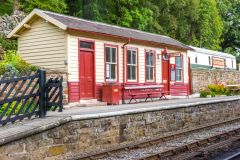
A scenic village in the east of the North York Moors National Park. Goathland is known as the setting for the popular television series Heartbeat. Goathland is also a popular stopping point on the North Yorkshire Moors steam railway.
A short walk from the village centre leads to beautiful Mallyan Spout waterfall, and there are further walks along the riverbank to smaller falls.
History
The village dates to at least the Viking period. One of the earliest written records comes from 1109 when Henry I gave land here in memory of his mother to a hermitage under control of a priest named Osmund.
The land passed to the Duchy of Lancaster, and one of the enduring historic features of Goathland is that the Duchy's tenants had the right to graze their sheep on the village green. This right is still exercised today, and the sight of black-faced sheep wandering around the village and the surrounding moors is a common one.
During the 19th century, Goathland enjoyed brief popularity as a spa centre, with the railway bringing visitors keen to enjoy the healthy waters. Several hotels sprang up to serve the visitors, but of these only one large one remains; the Mallyan Spout Hotel, an attractive country house hotel built in 1892.
Behind the hotel, a trail leads down a wooded hillside to emerge at Mallyan Spout waterfall, the most popular falls in the North York Moors, set in a lovely wooded gulley.

During the 1960s Goathland was used as the setting for the Heartbeat television series where it served as the mythical village of Aidensfield. After filming for many years in and around the village and using local buildings as part of the background, the producers built a replica of the village inside a film studio, and the remainder of the series was filmed in that 'false' Goathland.
Local businesses make much of the Heartbeat connection. One village shop is painted with a sign proclaiming it to be Aidensfield Stores and the shop window is filled with goods from the Heartbeat time period. When we visited there were cars from the TV series parked in front of the shops. One was the actual Ford Anglia police car used in the series. Another was an Austin A40 Countryman Estate used in several episodes.
Between the railway station and the village shops is another Heartbeat building; the Aidensfield Garage, now converted into a convenience store.
The North York Moors steam railway passes through Goathland. The railway is run by volunteers and carries about 250,000 visitors annually between Grosmont and Pickering, on the route constructed in 1835 by George Stephenson. Goathland railway station also featured in the Harry Potter series of films where it served as Hogsmeade station.
Goathland is a very popular place to watch steam trains pulling into and out of the station. There is a footbridge directly over the railway tracks, and when a train is arriving people are often lined up on the bridge waiting to get a good photo of the steam locomotives in action. In August you can also climb the slope above the station for lovely views down the heather-clad hill to the train platform.
Near the village green is the Goathland Reading Room, an attractive brick building erected in 1894.

St Mary's Church
The parish church of St Mary is a late Victorian rebuilding of an earlier 19th-century church, which in turn replaced an Elizabethan building, itself a replacement for a 12th-century church on a different site! The most interesting historic feature is a 12th-century stone altar slab, with 5 small consecration crosses carved into the surface.
There is a royal coat of arms to George III and an early 17th-century wooden pulpit. Much of the woodwork inside St Mary's was carved by Robert Thompson of Kilburn, the 'mouse man'. Look for 9 (and a half) carved mice, Thompson's signature device, and there is one more that can be felt but not seen on the north-west window sill!
Just two miles away from Goathland is Wheeldale Moor Roman road.
About Goathland
Address: Goathland,
North York Moors,
Yorkshire,
England
Attraction Type: Village
Location map
OS: SE834994
Photo Credit: David Ross and Britain Express
HERITAGE
 We've 'tagged' this attraction information to help you find related historic attractions and learn more about major time periods mentioned.
We've 'tagged' this attraction information to help you find related historic attractions and learn more about major time periods mentioned.
Historic Time Periods:
Find other attractions tagged with:
12th century (Time Period) - 17th century (Time Period) - 19th century (Time Period) - Elizabethan (Architecture) - George III (Person) - Henry I (Person) - Roman (Time Period) - Victorian (Time Period) - Viking (Historical Reference) -
NEARBY HISTORIC ATTRACTIONS
Heritage Rated from 1- 5 (low to exceptional) on historic interest
Goathland, St Mary's Church - 0.9 miles (Historic Church) ![]()
Mallyan Spout - 1.2 miles (Countryside) ![]()
Thomason Foss - 1.9 miles (Countryside) ![]()
Wheeldale Roman Road - 1.9 miles (Roman Site) ![]()
Grosmont, St Matthew's Church - 3.6 miles (Historic Church) ![]()
Beggar's Bridge - 4.9 miles (Historic Building) ![]()
The Bridestones - 5.5 miles (Countryside) ![]()
Cawthorn Roman Camps - 6.7 miles (Roman Site) ![]()











